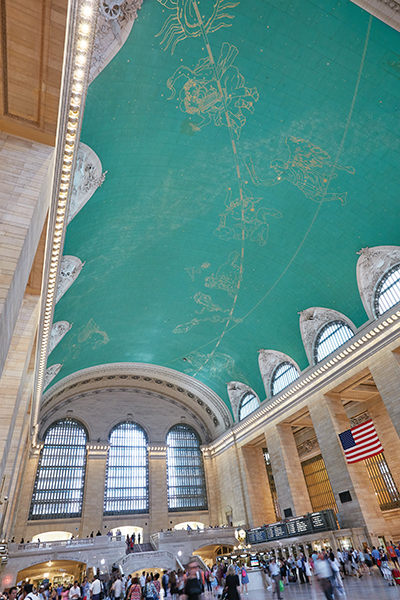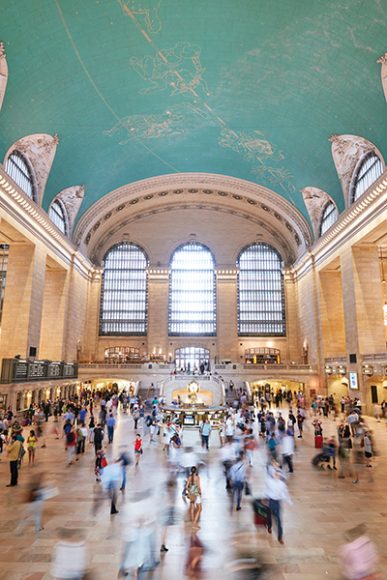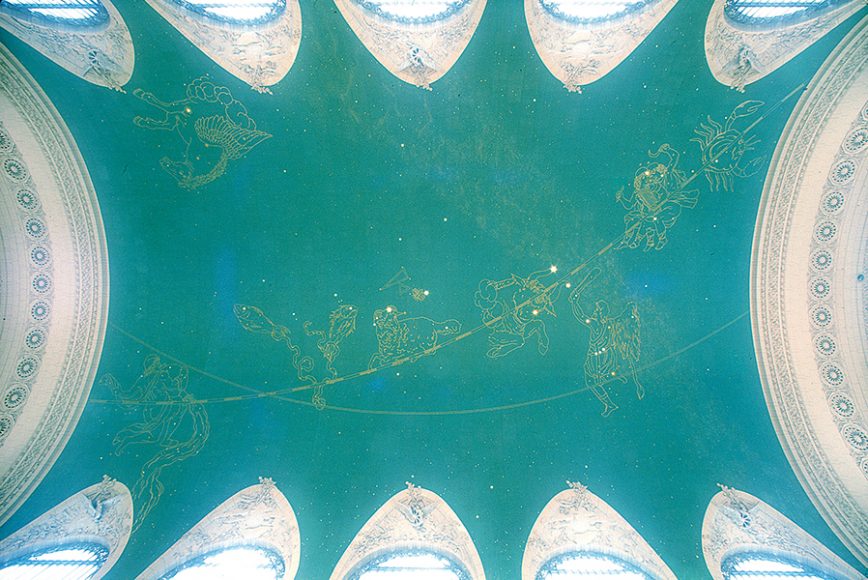For more than a century, generations of commuters — and countless visitors — have been passing under Grand Central Terminal’s majestic celestial ceiling.
Ever since the transportation hub opened amid grand fanfare on Feb. 2, 1913, the sprawling painting has been inspiring more than just awe.
The cover of the holiday edition of Connections, “the magazine devoted to all things Grand Central,” for example, featured the ceiling’s imagery gracing a seasonal sky.

In 2013, when the National Historic Landmark officially marked its centennial, jewelry company Erwin Pearl famously interpreted elements of the ceiling in its bracelets, pendants and earrings, which are still sold today.
Also timed to commemorate its first hundred years, a companion book, “Grand Central Terminal: 100 Years of a New York Landmark” by the New York Transit Museum and Anthony W. Robins was published by Stewart, Tabori & Chang. The keepsake volume — which has been a part of WAG’s library ever since we covered the centennial for our March 2013 issue —offers a trip through the terminal’s storied history, filled with historic images of its iconic elements, including the Paul-César Helleu celestial ceiling on the Main Concourse.
Its grandeur is captured in a quote in The New York Times on Jan. 29, 1913, as featured in the book: “‘Fortunately there are no seats in the concourse,’ remarked one of the railway officials on the inspection tour, ‘or I would fear that some passengers might miss their trains while contemplating this starry picture.’”
The massive painting, an arching design featuring the zodiac, originally included some 60 electric bulbs to add twinkle to the project designed in consultation with a Columbia University professor of astronomy. Despite its pedigree, it’s noted as well for its “backward” orientation and as it’s considered a work of decoration has never been corrected.
Nevertheless, it remains, as it has for more than a century, a beacon to travelers, today watching over those below with energy-efficient LEDs, part of the terminal’s green initiatives.
Looking for more of the inside scoop, WAG turned to an expert, with Aaron Donovan, the deputy communications director of the Metropolitan Transportation Authority, taking the time to answer our questions about the beloved Grand Central Terminal feature:
Do today’s visitors/commuters stop, do you think, and try to admire its beauty?
“Of course, New York City is known for its busy commuters and ‘hustle and bustle’ mindset, which Grand Central embraces. Each day sees swarms of people running to catch trains or families and commuters zigzagging across the Main Concourse. However, the ceiling tends to be a great distraction that does captivate a good majority of the crowds — not just tourists, but commuters who have a moment to kill before rushing off to the office or those waiting to meet someone by the clock. There is something about the ceiling’s grandeur, the way it envelops the space, that gives Grand Central its unique beauty and adds a welcome calming effect to an otherwise bustling environment.”
Are there any special requirements for its upkeep — such as retouching, cleaning etc. —and if so, how/when are they completed?
“Over time, as with anything, dirt and grime can become an issue. When Grand Central was threatened to be demolished in the 1970s, there was a call for a restoration initiative that would save the landmark from destruction, so the terminal could hold on to its architectural grandeur. As part of an effort to raise funds for the restoration master plan in the 1990s, (the architectural firm) Beyer Blinder Belle cleaned a patch of the sky mural to reveal how beautiful the ceiling once was and could be again. Clearly, the ceiling had enough of an impact on the space that it was restored to its original glory with some simple cleaning procedures.”
Is the ceiling and its zodiac-themed work considered a gem of GCT?
“Absolutely. Grand Central is so much more than just a terminal. It is a destination for all walks of life to enjoy and the ceiling really emphasizes that quality. Part of what makes Grand Central such an iconic landmark is its unique and beautiful architecture that has never been redesigned or destroyed, only restored to keep its originality and character. The ceiling is relevant in many ways, such as the GE women in STEM campaign earlier in September that featured groundbreaking female scientists in an installation titled ‘Unseen Stars,’ and is a definitive aspect of what makes Grand Central a place of exploration and awe. Its intricate zodiac-themed work still amazes crowds to this day and has been one of the many characteristics of Grand Central that establishes it as a place of culture, history, art and more for all to experience.”
Any “secrets” or behind-the-scenes tidbits you’d care to share about it?
“The starry ceiling was not originally in the plans for Grand Central, which called for a skylight. With time and money running out, architect Whitney Warren turned to a friend to create an affordable alternative. Hence, the zodiac-themed ceiling came to be.”
For more, visit grandcentralterminal.com or gcthistory.com.






